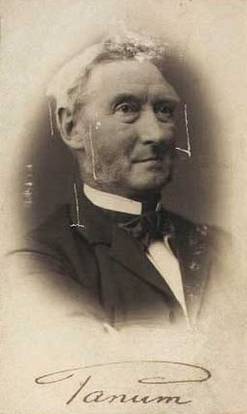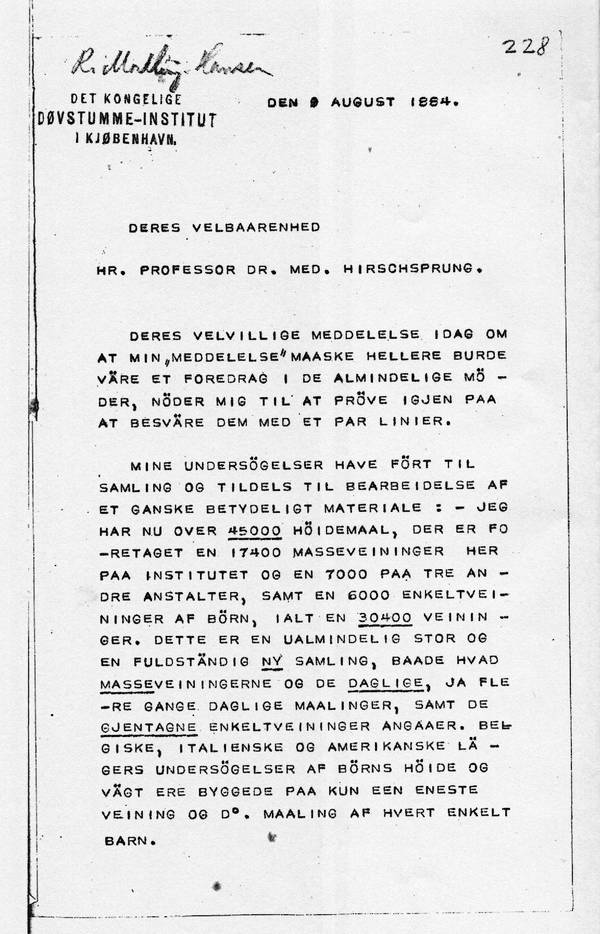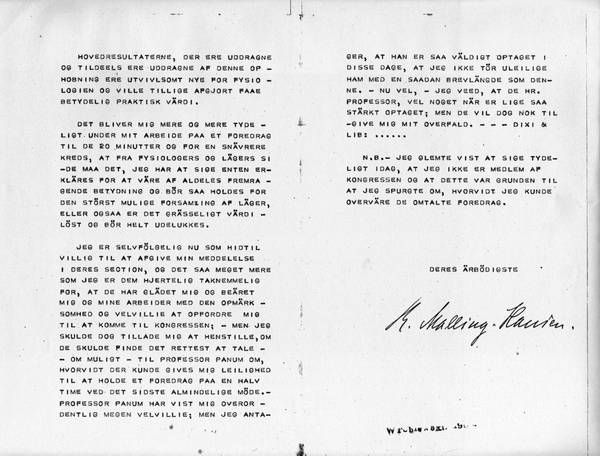1884.08.09 English
ROYAL INSTITUTE AUGUST 9, 1884
FOR THE DEAF-MUTE
COPENHAGEN
YOUR HONOUR
PROFESSOR HIRSCHSPRUNG, MD
YOUR KIND NOTIFICATION TODAY, SUGGESTING THAT MY “MESSAGE” PERHAPS SHOULD BE TURNED INTO A DISCOURSE TO BE DELIVERED AT A GENERAL MEETING, CAUSES ME TO ONCE AGAIN INCONVENIENCE YOU WITH A COUPLE OF LINES.
MY RESEARCH HAS RESULTED IN THE COLLECTION AND ANALYSIS OF QUITE A CONSIDERABLE MATERIAL: - AT PRESENT I HAVE MORE THAN 45,000 HEIGHT MEASURINGS, WHILE HERE AT THE INSTITUTE WE HAVE CARRIED OUT SOME 17,400 GROUP WEIGHINGS IN ADDITION TO SOME 7,000 WEIGHINGS AT THREE OTHER INSTITUTIONS, AS WELL AS CIRCA 6,000 INDIVIDUAL WEIGHINGS OF CHILDREN, MAKING A TOTAL OF SOME 30,400 WEIGHINGS. THIS IS AN UNUSUALLY BIG AND COMPLETELY NEW COLLECTION AF DATA BOTH IN RESPECT OF GROUP WEIGHINGS AND THE DAILY WEIGHINGS – EVEN SEVERAL TIMES A DAY – AND IN RELATION TO THE REPEATED INDIVIDUALS WEIGHINGS. THE INVESTIGATIONS BY BELGIAN, ITALIAN AND AMERICAN PHYSICISTS CONCERNING THE HEIGHT AND WEIGHT OF CHILDREN WERE BASED UPON ONLY ONE SINGLE WEIGHING AND MEASURING OF EACH INDIVIDUAL CHILD.
THE MAIN RESULTS DERIVED AND BEING DERIVED FROM THIS MASS OF DATA ARE UNDOUBTEDLY NEW TO THE SCIENCE OF PHYSIOLOGY AND, IN ADDITION, WOULD BE OF UNQUESTIONABLE PRACTICAL VALUE.
IN THE COURSE OF MY PREPARATORY WORK ON THE 20 MINUTE DISCOURSE TO BE DELIVERED TO A SMALL NUMBER OF PEOPLE, IT SEEMS TO ME INCREASINGLY EVIDENT THAT FROM THE POINT OF VIEW OF PHYSIOLOGISTS AND PHYSICISTS WHAT I HAVE TO PUT FORWARD WILL EITHER BE CONSIDERED OF OUTSTANDING IMPORTANCE AND, AS SUCH, OUGHT TO BE PRESENTED TO AS LARGE AN ASSEMBLY OF MEDICAL PROFESSIONALS AS POSSIBLE; OR IT WILL BE FOUND TO BE TERRIBLY WORTHLESS AND SHOULD BE TOTALLY EXCLUDED.
I REMAIN, OF COURSE, AT DISPOSITION TO PRESENT MY ADDRESS IN YOUR SECTION, SO MUCH MORE SINCE I AM IMMENSELY GRATEFUL TO YOU FOR PROVIDING ME AND MY RESEARCH WORK THE PLEASURE AND HONOUR OF PAYING ME ATTENTION AND ENCOURAGING ME TO ADDRESS THE CONGRESS; - HOWEVER, I AM TAKING THE LIBERTY TO KINDLY REQUEST WHETHER YOU WOULD FIND IT PROPER TO APPROACH – IF POSSIBLE – PROFESSOR PANUM WITH THE QUESTION WHETHER I COULD BE ALLOWED THE OPPORTUNITY TO GIVE A THIRTY MINUTES LECTURE AT THE LAST GENERAL ASSEMBLY. – PROFESSOR PANUM HAS SHOWN ME AN EXTRAORDINARY DEGREE OF KINDNESS AND FAVOUR; BUT I TAKE IT THAT HE IS SO VERY BUSY THESE DAYS THAT I DARE NOT INCONVENIENCE HIM WITH SUCH A LONG EPISTLE AS THIS. – WELL, - I AM WELL AWARE THAT YOU, PROFESSOR, ARE PERHAPS EQUALLY ENGAGED; BUT YOU WILL FORGIVE THAT I AM JUMPING UPON YOU LIKE THIS, WON’T YOU?. - - -DIXI & LIB:…..
N.B. – I THINK I FORGOT TO STATE CLEARLY TODAY THAT I AM NOT A MEMBER OF THE CONGRESS AND THAT THIS WAS THE REASON WHY I ASKED WHETHER I COULD ATTEND THE SAID LECTURES.
YOURS FAITHFULLY
R. Malling-Hansen (by hand)
SA: The international medical congress in Copenhagen took place between August 10 and 16, 1884, and hence this letter, in which Malling-Hansen requests permission to speak for 30 minutes, addressing the most prominent participants on the last day of the congress, was written the day before the opening of the congress. It was therefore with good reason that he assumed that boththe president, Peter L. Panum, and Harald Hirschsprung, were very busy! Panum had made enormous efforts to ensure that the congress took place in Copenhagen, and it is said that he destroyed his health in connection with the gigantic workload involved, because he passed away already the following year. Everything indicates that RMH had his wish fulfilled to speak on the last day of the congress, because already two days later, August 18, he sends a summary of his lecture to his friend, Edgar Collin, journalist at the daily newspaper “Nationaltidende” and requests that it be accepted for publication.
Information from Wikipedia concerning Panum:
Peter Ludvig Panum (19 December 1820 – 2 May 1885) was a Danish physician and physiologist. He got his medical degree in 1848, but already by that time he was working as a medical student with the dreaded cholera epidemics. He was awarded The Knight Cross of the Order of the Dannebrog for his achievements in connection with the great cholera epidemic at Bandholm in the island of Lolland in 1853. He is also recognized for his research in the disease of measles in connection with an outbreak in the Faroe Islands. As from 1853 he was professor of physiology in Kiel before returning to the University of Copenhagen in 1864. The Panum Institute was named after him.
Harald Hirschsprung (1830-1916) is known internationally for discovering and describing a congenital genetic disease still known as Hirschsprung’s Disease. Hirschprung was also a cholera doctor in 1853 and took his doctor’s degree in 1861. He was appointed professor in 1877, and in 1892 lecturer at the university. In 1884 Hirschsprung was president of the pediatric section of the international medical congress in Copenhagen.




